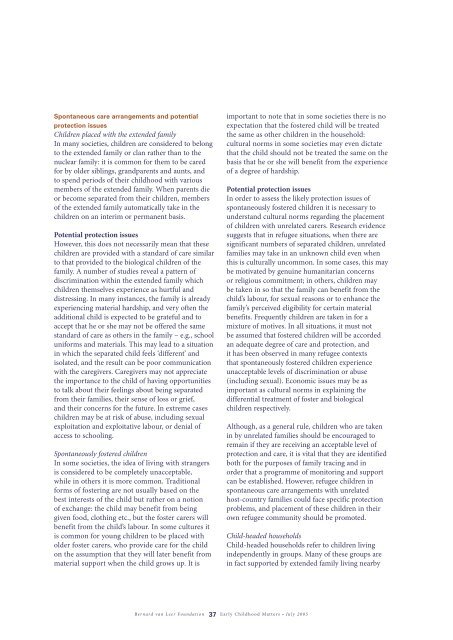Responses to young children in post-emergency situations
Responses to young children in post-emergency situations
Responses to young children in post-emergency situations
You also want an ePaper? Increase the reach of your titles
YUMPU automatically turns print PDFs into web optimized ePapers that Google loves.
Spontaneous care arrangements and potential<br />
protection issues<br />
Children placed with the extended family<br />
In many societies, <strong>children</strong> are considered <strong>to</strong> belong<br />
<strong>to</strong> the extended family or clan rather than <strong>to</strong> the<br />
nuclear family: it is common for them <strong>to</strong> be cared<br />
for by older sibl<strong>in</strong>gs, grandparents and aunts, and<br />
<strong>to</strong> spend periods of their childhood with various<br />
members of the extended family. When parents die<br />
or become separated from their <strong>children</strong>, members<br />
of the extended family au<strong>to</strong>matically take <strong>in</strong> the<br />
<strong>children</strong> on an <strong>in</strong>terim or permanent basis.<br />
Potential protection issues<br />
However, this does not necessarily mean that these<br />
<strong>children</strong> are provided with a standard of care similar<br />
<strong>to</strong> that provided <strong>to</strong> the biological <strong>children</strong> of the<br />
family. A number of studies reveal a pattern of<br />
discrim<strong>in</strong>ation with<strong>in</strong> the extended family which<br />
<strong>children</strong> themselves experience as hurtful and<br />
distress<strong>in</strong>g. In many <strong>in</strong>stances, the family is already<br />
experienc<strong>in</strong>g material hardship, and very often the<br />
additional child is expected <strong>to</strong> be grateful and <strong>to</strong><br />
accept that he or she may not be offered the same<br />
standard of care as others <strong>in</strong> the family – e.g., school<br />
uniforms and materials. This may lead <strong>to</strong> a situation<br />
<strong>in</strong> which the separated child feels ‘different’ and<br />
isolated, and the result can be poor communication<br />
with the caregivers. Caregivers may not appreciate<br />
the importance <strong>to</strong> the child of hav<strong>in</strong>g opportunities<br />
<strong>to</strong> talk about their feel<strong>in</strong>gs about be<strong>in</strong>g separated<br />
from their families, their sense of loss or grief,<br />
and their concerns for the future. In extreme cases<br />
<strong>children</strong> may be at risk of abuse, <strong>in</strong>clud<strong>in</strong>g sexual<br />
exploitation and exploitative labour, or denial of<br />
access <strong>to</strong> school<strong>in</strong>g.<br />
Spontaneously fostered <strong>children</strong><br />
In some societies, the idea of liv<strong>in</strong>g with strangers<br />
is considered <strong>to</strong> be completely unacceptable,<br />
while <strong>in</strong> others it is more common. Traditional<br />
forms of foster<strong>in</strong>g are not usually based on the<br />
best <strong>in</strong>terests of the child but rather on a notion<br />
of exchange: the child may benefit from be<strong>in</strong>g<br />
given food, cloth<strong>in</strong>g etc., but the foster carers will<br />
benefit from the child’s labour. In some cultures it<br />
is common for <strong>young</strong> <strong>children</strong> <strong>to</strong> be placed with<br />
older foster carers, who provide care for the child<br />
on the assumption that they will later benefit from<br />
material support when the child grows up. It is<br />
important <strong>to</strong> note that <strong>in</strong> some societies there is no<br />
expectation that the fostered child will be treated<br />
the same as other <strong>children</strong> <strong>in</strong> the household:<br />
cultural norms <strong>in</strong> some societies may even dictate<br />
that the child should not be treated the same on the<br />
basis that he or she will benefit from the experience<br />
of a degree of hardship.<br />
Potential protection issues<br />
In order <strong>to</strong> assess the likely protection issues of<br />
spontaneously fostered <strong>children</strong> it is necessary <strong>to</strong><br />
understand cultural norms regard<strong>in</strong>g the placement<br />
of <strong>children</strong> with unrelated carers. Research evidence<br />
suggests that <strong>in</strong> refugee <strong>situations</strong>, when there are<br />
significant numbers of separated <strong>children</strong>, unrelated<br />
families may take <strong>in</strong> an unknown child even when<br />
this is culturally uncommon. In some cases, this may<br />
be motivated by genu<strong>in</strong>e humanitarian concerns<br />
or religious commitment; <strong>in</strong> others, <strong>children</strong> may<br />
be taken <strong>in</strong> so that the family can benefit from the<br />
child’s labour, for sexual reasons or <strong>to</strong> enhance the<br />
family’s perceived eligibility for certa<strong>in</strong> material<br />
benefits. Frequently <strong>children</strong> are taken <strong>in</strong> for a<br />
mixture of motives. In all <strong>situations</strong>, it must not<br />
be assumed that fostered <strong>children</strong> will be accorded<br />
an adequate degree of care and protection, and<br />
it has been observed <strong>in</strong> many refugee contexts<br />
that spontaneously fostered <strong>children</strong> experience<br />
unacceptable levels of discrim<strong>in</strong>ation or abuse<br />
(<strong>in</strong>clud<strong>in</strong>g sexual). Economic issues may be as<br />
important as cultural norms <strong>in</strong> expla<strong>in</strong><strong>in</strong>g the<br />
differential treatment of foster and biological<br />
<strong>children</strong> respectively.<br />
Although, as a general rule, <strong>children</strong> who are taken<br />
<strong>in</strong> by unrelated families should be encouraged <strong>to</strong><br />
rema<strong>in</strong> if they are receiv<strong>in</strong>g an acceptable level of<br />
protection and care, it is vital that they are identified<br />
both for the purposes of family trac<strong>in</strong>g and <strong>in</strong><br />
order that a programme of moni<strong>to</strong>r<strong>in</strong>g and support<br />
can be established. However, refugee <strong>children</strong> <strong>in</strong><br />
spontaneous care arrangements with unrelated<br />
host-country families could face specific protection<br />
problems, and placement of these <strong>children</strong> <strong>in</strong> their<br />
own refugee community should be promoted.<br />
Child-headed households<br />
Child-headed households refer <strong>to</strong> <strong>children</strong> liv<strong>in</strong>g<br />
<strong>in</strong>dependently <strong>in</strong> groups. Many of these groups are<br />
<strong>in</strong> fact supported by extended family liv<strong>in</strong>g nearby<br />
B e r n a r d v a n L e e r Fo u n d a t i o n 37 E a r l y C h i l d h o o d M a t t e r s • Ju l y 2 0 0 5
















